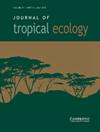Avifaunal feeding guilds’ response to landscape compositional heterogeneity and their drivers in forest mosaic, Uttarakhand, India
IF 1
4区 环境科学与生态学
Q4 ECOLOGY
引用次数: 0
Abstract
The positive association between landscape compositional heterogeneity and avian species richness is widely accepted, however, birds of different feeding guilds are expected to respond differently because of diverse resource utilisation patterns and ecological tolerance. In the present study, we assessed the response of avian species and avifaunal feeding guilds to landscape compositional heterogeneity and factors associated with their richness. Bird richness and landscape variables, edge density, landscape diversity, and area of land cover types were evaluated at 30 sampling sites in the Terai-Arc landscape of Uttarakhand, India. Univariate regression was performed to investigate the response of birds and various feeding guilds to landscape compositional heterogeneity. Average weighted models of most parsimonious generalised linear regression models (<Δ 2AICc) were developed for various feeding guilds to identify significant predictors of species richness. The richness of overall birds and most feeding guilds, except piscivores and frugivores, responded positively to landscape compositional heterogeneity at variable spatial scales. The scale of effect was largest for carnivore (1.5 km), followed by granivore (1 km), insectivore (0.75 km), and frugi-insectivore, nectarivore, and omnivore (0.5 km). Overall bird species richness was positively associated with landscape diversity, teak plantation, and Sal-mixed forest. The average-weighted models identified edge density and dry riverine forest for frugi-insectivore, barren land and water body for the carnivore, teak plantation, Sal-mixed forest and dry-riverine forest for insectivore, edge density, human habitation/agriculture, teak plantation, barren land and scrubland for granivore, human habitation/agriculture for omnivore and waterbodies for piscivore and frugivore guilds as the significant drivers of species richness. The study concludes that the response to landscape compositional heterogeneity differs among feeding guilds and varies with the spatial scale of analysis. The results of our study are expected to serve as a reference for future studies, exploring the landscape relationship to the avian community in similar environmental conditions.印度北阿坎德邦森林镶嵌中鸟类群落对景观组成异质性的反应及其驱动因素
景观组成异质性与鸟类物种丰富度之间的正相关关系已被广泛接受,然而,由于资源利用模式和生态耐受性的多样性,不同觅食群体的鸟类预计会有不同的反应。在本研究中,我们评估了鸟类物种和鸟类区系对景观组成异质性的反应以及与其丰富度相关的因素。在印度北阿坎德邦Terai Arc景观的30个采样点,对鸟类丰富度和景观变量、边缘密度、景观多样性和土地覆盖类型面积进行了评估。采用单变量回归方法研究了鸟类和各种饲养群体对景观组成异质性的反应。为各种饲养公会开发了最简约广义线性回归模型(<Δ2AICc)的平均加权模型,以确定物种丰富度的重要预测因素。除食豆动物和食草动物外,总体鸟类和大多数觅食群体的丰富度对可变空间尺度上的景观组成异质性做出了积极反应。食肉动物的影响范围最大(1.5公里),其次是食草动物(1公里)、食虫动物(0.75公里),以及弗鲁吉食虫动物、蜜腺动物和杂食动物(0.5公里)。总体鸟类物种丰富度与景观多样性、柚木种植园和萨尔混合林呈正相关。平均加权模型确定了弗鲁吉食虫动物的边缘密度和干河岸森林,食肉动物的贫瘠土地和水体,柚木种植园,食虫生物的萨尔混合林和干河岸林,边缘密度,人类居住/农业,柚木植物种植园,贫瘠土地和灌木林,杂食动物的人类居住/农业以及鱼类和食草动物协会的水体是物种丰富度的重要驱动因素。研究得出的结论是,不同饲养公会对景观组成异质性的反应不同,并且随着分析的空间尺度而变化。我们的研究结果有望为未来的研究提供参考,探索类似环境条件下鸟类群落的景观关系。
本文章由计算机程序翻译,如有差异,请以英文原文为准。
求助全文
约1分钟内获得全文
求助全文
来源期刊

Journal of Tropical Ecology
环境科学-生态学
CiteScore
2.10
自引率
0.00%
发文量
44
审稿时长
18-36 weeks
期刊介绍:
Journal of Tropical Ecology aims to address topics of general relevance and significance to tropical ecology. This includes sub-disciplines of ecology, such as conservation biology, evolutionary ecology, marine ecology, microbial ecology, molecular ecology, quantitative ecology, etc. Studies in the field of tropical medicine, specifically where it involves ecological surroundings (e.g., zoonotic or vector-borne disease ecology), are also suitable. We also welcome methods papers, provided that the techniques are well-described and are of broad general utility.
Please keep in mind that studies focused on specific geographic regions or on particular taxa will be better suited to more specialist journals. In order to help the editors make their decision, in your cover letter please address the specific hypothesis your study addresses, and how the results will interest the broad field of tropical ecology. While we will consider purely descriptive studies of outstanding general interest, the case for them should be made in the cover letter.
 求助内容:
求助内容: 应助结果提醒方式:
应助结果提醒方式:


